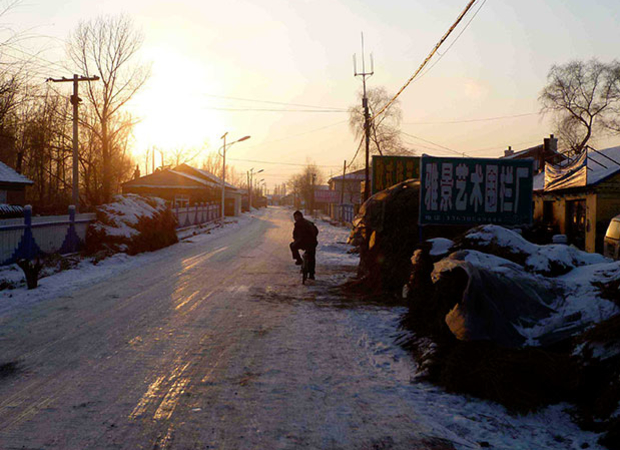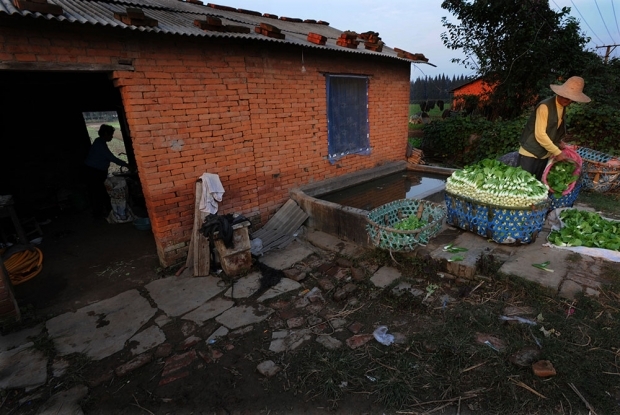James Carter spent much of the 1990s researching the modern history of Harbin, China’s northernmost major city, in the region that is today known as dongbei, the northeast. That region is the subject of Michael Meyer’s forthcoming book, In Manchuria: A Village Called Wasteland and the Transformation of Rural China. We invited Carter and Meyer to discuss the book, the region, and how to survive its ferocious winters. —The Editors
James Carter: The term “Manchuria” is a loaded one in China today because of its perceived associations with imperialism and the implication that the region is not “really Chinese.” Following the lead of the Chinese government, many authors avoid the word altogether. You not only use the term, but make it the title of the book. How and why you did you decide to go with that title?
Michael Meyer: It’s an evocative word, and a beautiful one, too, with deep personal meaning to me—having spent years exploring the region and its history—and my wife, who is from there. The book explains its many connotations, much like The Last Days of Old Beijing details a 600-year-long series of “last days” of “old Beijing.”
Excerpts
01.28.15
The View from Wasteland
As to the word’s denotation, “Manchuria” predates “Manchukuo”—the Japanese puppet state—and survived past it, too, even being used at times by the Communist Party as shorthand for “the Northeast.” Of course today the region is called dongbei, and the Chinese edition of my book is “东北游记,” Journey to the Northeast, a play on the classic novel Journey to the West. But “In the Northeast” is a lousy title in English, so I opted for the homage to In Patagonia and In Siberia. The Modern China bookshelf lacked a love letter to its most captivating region.
That attachment to place comes through clearly in the book. Early on, you contrast your book with the “scar literature” of many Cultural Revolution memoirs that illustrate the destruction so common to China’s 20th-century history. You write (on page 31), “This is not that China story.” What “China story” is it?
A story of construction, rather than destruction. A region shaped by “outsiders”—foreigners and Chinese migrants; a farming village manufactured from swampland; a working-class family whose lives steadily improve across generations.
Construction, of course, has also been a hallmark of modern China. When I was in Harbin in the 1990s, I witnessed the reconstruction of St Sofia’s cathedral: a Russian orthodox church repurposed as, essentially, scenery for wedding portraits. I laughed when I read how the city of Manzhouli—near both the Russian and Mongol borders—is building a “cathedral” explicitly as a backdrop for wedding portraits!
The CCP has an uncomfortable relationship to its past and this is especially evident in Dongbei; it also seems deeply fearful—or at least anxious—about the future. It was exciting to read the ways you glimpsed your personal future in Manchuria, but if, as you write, you glimpsed China’s future there too, what did you see? And was it connected to this past?
Just as the past 20 years have seen a drive to create modern cities, a property market, a car culture, and a middle class, I think the next 20 years will see the focus turned to the countryside. As of 2013, the central government has called for larger managed farms—a byword for company-controlled mechanized operations, which can increase yields and better control food quality and safety. That’s one glimpse of the future. The larger issue is land rights, and whether farmers will be allowed to use their assigned plots to mortgage and raise capital for improvements, or to freely sell and move away forever. This is unimaginable to a generation of farmers who witnessed land redistribution in the 1950s. But China has now spent more years dismantling a Marxist economy than it did building one.
How cold was it?
It’s funny, no one had a [thermometer], as if the measurement could never explain just how cold it was. The wind was the killer; it just sliced you in two, no matter how many layers you had on. Often in Jilin the newspaper would just show a string of -18 degrees Celsius [-4 degrees Fahrenheit]. It was similar to my time in Sichuan as a Peace Corps volunteer, when summers were so hot and humid the temperature in weather forecasts seemed capped at 39 degrees Celsius [102 degrees Fahrenheit], since work had to be halted by law once the mercury made it past 40. Frankly, I prefer the cold.
I became attached to the place, constantly struck by how that part of the country both exemplified and contradicted China’s master narrative: changing rapidly, yet left behind; a cosmopolitan history, yet resistant to outsiders. I was repeatedly impressed with how your book gives the reader ways to understand those contradictions.
I often found myself thinking that Manchuria’s past was much more inviting that its present. Perhaps for that reason I was struck by a line uttered by a woman selling vegetables in the city of Ang’angxi: “If you’re looking for history, you’ve come too late” (p. 128). If In Manchuria is a love letter to the Northeast, is it wooing its past, or its present?
It’s wooing its present—and, not to give away the story’s end, its future as well. But about that past: it’s incredible in comparison to—and yet how it illustrates—greater China’s. And you can see it, and step inside it, and touch it, and still hear it told by people who lived through land reform, the civil war, occupation, and even warlords—all linked by railways planned by Russians, Japanese, and Chinese, through paddies first planted by Koreans. As a foreigner, I didn’t feel so foreign there. I was just the latest to pass through, and certainly not the first American, as the book explains.
I know what you mean. I often noticed how the conservatism of many regional officials contrasted with the internationalism of the past I was researching. In part, that international past helped explain the conservatism.
Speaking of officials, you were in Dalian during Bo Xilai’s time. Bo, especially in his subsequent posting as Chongqing’s Communist Party Secretary, was once considered one of the rising stars of contemporary Chinese politics before his crash, in 2012, amid scandals involving murder, corruption, and influence peddling. Did your experience of Bo’s Dalian give you particular insights or ideas on his subsequent career and its spectacular end?
The more surprising plummet from power is the onetime soccer powerhouse Dalian Wanda’s demise. As someone interested in How Cities Work, what interested me about Mr. Bo was how he became the face of the city, and its improvements, as if he were campaigning for reelection. That was—and remains—rare in China, where most people can’t name their mayor, let alone see the quality-of-life improvements that were implemented in Dalian in the 1990s. He seemed to have a Bloombergesque presence in that regard, cutting the ribbon on cleaned up beaches, coastal roads, the trolley, and those genius overpasses that eliminated left-turn congestion in the city center. I’d like to know where the young, junior-level officials during that administration ended up; did they take what they learned and go on and spearhead civic improvements in other cities? Or are they lording over a town as if it were their fiefdom?
The book stands out for its remarkable anecdotes, in a genre that is justly famous for producing great anecdotes. What was the best story (or, the story you most wanted to put in) that you didn’t include in the final draft of the book, and why did it get left out?
With this much material, I had to be judicious about what to include, lest the reader tire and stop turning the page. The first draft was 160,000 words; the final is 95,000. The excised material could make another book, if anyone is interested in reading about train rides, a tiger preserve, and the mean streets of Heihe. [Sound of crickets chirping.] Now, In Manchuria is of a piece, and accomplishes what I set out to do when I began it five years ago.
The book clearly is of a piece (though the tiger preserve, and its “Jurassic Park” approach to tourism is always a good tale to tell).
I mentioned earlier that the book’s tone is very optimistic, even when it’s describing hardship or hard times. Most of the people I knew in Harbin, particularly, saw a bleak future for the city and the region: Work units were broke and not paying their workers, or not heating their workers’ apartment blocks. The city library was converting its reading rooms into disco bars and pool halls to try to pay the bills. The timing’s not exactly the same, but what do you think accounts for the difference in those perceptions?
The late ’90s, early ’00s were a terrible time for the region, with the massive lay-offs from state-owned enterprises. I heard tell of people subsisting on chicken feed, for example, and in the book revisit that era in Shenyang’s Worker’s Village neighborhood, once the paragon of a manufacturing-based “iron rice bowl” community. The Worker’s Cultural Palace had become a front for prostitution, evictees were camped outside their demolished apartments, warming themselves by bonfires built from scavenged moldings and used IV bags filled with boiled water. How the region pulled out of those times would itself be a fascinating book, as would the debate over its title. A Prairie Home Pump-Priming, perhaps. And as far as cities go, the region still lags behind others. Its agricultural sector has remained steady, however, and in the book I take pains to say that Wasteland is not a typical Chinese farming village (in part because Chinese farms are too diverse in crops and size, nationwide, to even say there is such a thing as a typical farming village). Wasteland is comparatively prosperous, in a province with the nation’s highest literacy rate. Migration in Wasteland is for education, not manufacturing jobs, and many people return, or at least keep their roots there. It took me months to find a vacant house, for example. I arrived thinking farmers nationwide had dropped their hoes and abandoned their cows and hopped on the next train for the coast.
One aspect of the book I enjoyed was the use of the traditional Chinese agricultural calendar’s Solar Terms as a framing device that seemed to heighten the contrast between traditional and modern. What gave you the idea to use that device, and how did it help you tell the story?
For about a decade, I had taped over my desk—or packed into a suitcase—a tattered photocopy of the Solar Terms. I knew I’d use them some day, somehow. The change in seasons on a farm is a matter of life or death, for both the crops and—historically—the people. So I used those to contrast the historical eras and those stories. Two kinds of time, in other words: one eternal, and recurring; one ephemeral, and past.




